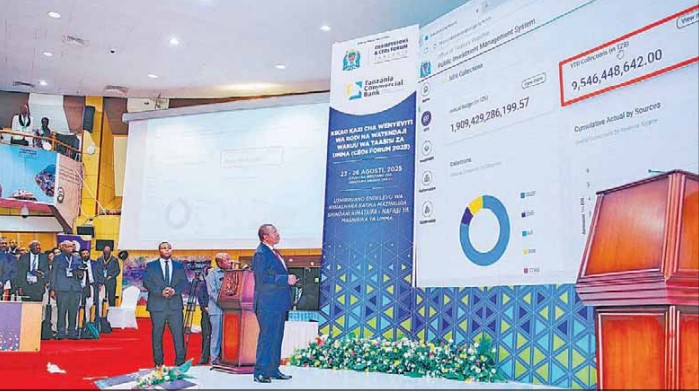Why Tanzania’s new Investment Dashboard is key to transforming public entities

FOR Tanzania’s public institutions and government agencies, the launch of the Office of the Treasury Registrar’s (OTR) Public Investment Management System (PIMS) marks a turning point. More than just a digital tool, the performance monitoring dashboard is fast becoming the backbone of public sector transformation—ushering in real-time oversight, smarter decision-making and a new culture of accountability across state-owned entities.
On August 24, 2025, at the opening of the CEOs Forum 2025 held at the Arusha International Conference Centre (AICC), Vice-President Dr Philip Mpango symbolically pressed the “launch button” before an audience of more than 650 board chairpersons and chief executives of public entities.
The moment underscored a simple truth: Tanzania’s vast network of public investments worth 86.25tri/- can no longer be managed by outdated systems and delayed reports. A modern economy demands modern oversight.
Protecting public wealth in real time
At the heart of PIMS lies a critical national priority: Safeguarding 86.25tri/- currently invested in public institutions and companies in which the government has minority shares.
“These investments, both large and small, require effective monitoring to ensure optimal performance and accountability,” Dr Mpango stressed during the launch.
The system is designed to protect these assets by providing leaders with continuous visibility into institutional performance, enabling corrective actions before issues escalate into costly losses.
“I look forward to seeing this system fully operational across the country,” Dr Mpango said.
“My desire is for every public institution and government agency to utilise the Public Investment Management System, so that all investments are monitored and every decision is informed by real-time data.”
Closing information gaps in Public Sector management
The Treasury Registrar, Nehemiah Mchechu, explained that PIMS was developed to address persistent gaps in the management of public investments.
“Previously, the government struggled with the lack of accurate and timely information about investments and the performance of public corporations—information that is critical for decision-making at different levels,” Mchechu said.
“To resolve this, we developed the Public Investment Management System (PIMS).” Mr Mchechu emphasised that the dashboard is designed to increase transparency, accountability and effective monitoring. “The leadership dashboard has been built specifically to give senior decision-makers—including the Treasury Registrar and top government leaders—a clear, real-time view of performance,” he explained.
Through this dashboard, he expounded, the OTR will strengthen accountability, transparency and efficiency in management, ultimately protecting and improving public investments. Accessible through dashboard.tro.go.tz, the platform is already live for institutions nationwide.
How the dashboard works
Developed in collaboration of experts from various public entities, the dashboard leverages advanced ICT to track performance without the need for physical inspections. Mr Donald Juma, the Acting Director of ICT at the Treasury Registrar’s Office, highlighted the operational power of the dashboard.
“Through this dashboard, the OTR can monitor revenue streams, access real-time statistics and evaluate performance without visiting each institution,” he said.
“The dashboard was created with user-friendliness and efficiency at its core.” “It provides decision-makers with simplified, real-time access to critical data, ensuring that performance can be tracked and acted upon immediately.”
According to Mr Juma, the system organises information into four key clusters. The first covers Non-Tax Revenue collection, highlighting trends against targets and including contributions, dividends and loan repayments. The second focuses on government investments, providing financial insights into both commercial and non-commercial Public and Statutory Corporations (PSCs).
The third addresses governance, offering updates on boards and chief executives while tracking compliance and leadership performance. The fourth delivers detailed institution-specific metrics, allowing users to identify progress or underperformance at each entity.
From data to smarter decisions
The analytical value of PIMS lies not only in its numbers but in what those numbers enable. By benchmarking against peers, institutions can identify underperformance, adopt best practices and cultivate a culture of continuous improvement. For policymakers, consolidated data sharpens governance.
President, the Chief Secretary, ministers and permanent secretaries can use real-time evidence from the dashboard to guide policy, allocate resources and evaluate interventions.
Tiered access ensures that these top government leaders, along with board chairpersons and institutional executives, can all view the relevant performance data in real time, making decision-making both timely and evidence-based. In this way, institutional performance is directly linked to national objectives.
Beyond the balance sheet
The dashboard’s scope extends beyond financial monitoring. It tracks executive profiles, evaluates compliance with performance contracts and measures progress toward strategic goals. By doing so, it provides a holistic view of public sector health, blending financial vigilance with leadership accountability.
This digital oversight tool also introduces a new level of transparency. Public executives can no longer hide behind delayed reports or opaque accounting systems. Performance is visible, measurable and comparable across the sector.
A strategic imperative for transforming public institutions
The government’s growing portfolio of public investments demands a monitoring mechanism that is as dynamic as the economy it supports. With Sh86.25 trillion on the line, real-time monitoring is not just a technical upgrade, it is an operational safeguard.
PIMS addresses key governance challenges: it enhances accuracy by minimising reporting errors, enforces accountability by tying leaders to performance contracts and ensures alignment by linking institutional results directly to national development priorities.
For CEOs and board chairpersons, the message is clear: Connecting to the system is no longer optional. It is a strategic imperative that strengthens institutional credibility and ensures resources deliver value to citizens.
Looking ahead
As PIMS evolves, its integration with other government systems will broaden its analytical reach and deepen its role in governance. Long-term, the dashboard promises to enhance institutional learning, support strategic planning and ensure that every shilling of public investment is tracked and accounted for.
The enthusiastic response from participants at the launch underscored the system’s potential to reshape governance. By marrying technology with accountability, Tanzania is positioning itself to maximise public value from its investments while nurturing public trust. The Public Investment Management System is more than a digital tool, it is a governance revolution.
With it, Tanzania is not only monitoring its public sector in real time but also charting a course toward a more efficient, transparent and accountable future.
Prepared by Office of the Treasury Registrar





